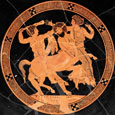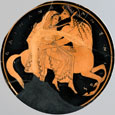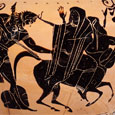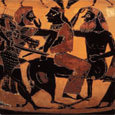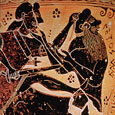NESSOS
Greek Name
Νεσσος
Transliteration
Nessos
Latin Spelling
Nessus
Translation
Duck? (nêssos)
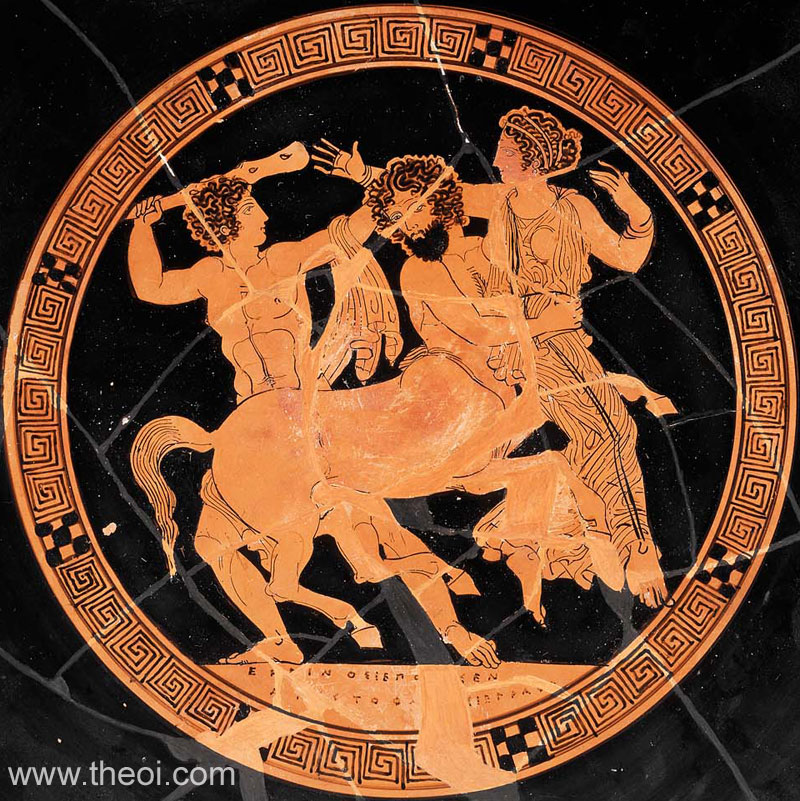
NESSOS (Nessus) was one of Thessalian Kentauroi (Centaurs). He fled his homeland after the Lapith war and made his way to the Aitolian river Euenos (Evenus) where he set himself up as a ferryman. When Herakles arrived with his new bride Deianeira, Nessos carried her across the river on his back. The sight of the beautiful woman, however, inflamed him with passion and he attempted to violate her. Herakles heard her cries and slew Nessos with a poisoned arrow. As he was dying the kentauros persuaded Deianeira to take some of his poisoned blood as a love charm should Herakles ever prove unfaithful. This dupe worked and eventually resulted in the hero's death.
Nessos' name probably means "the duck"--a fitting title for a ferryman who carries passengers across a river on his back.
FAMILY OF NESSUS
PARENTS
[1] IXION & NEPHELE (Hyginus Fabulae
34)
[2] Perhaps SEILENOS & MELIA
ENCYCLOPEDIA
NESSUS (Nessos). A centaur, who carried Deianeira across the river Evenus, but, wishing to run away with her, ie was slot by Heracles with a poisoned arrow, which afterwards became the cause of Heracles' own death. (Soph. Trach. 558; Apollod. ii. 7. § 4; comp. Heracles.) Heracles had been married to Deianeira for nearly three years, when, at a repast in the house of Oeneus, he killed, by an accident, the boy Eunomus, the son of Architeles. Heracles, in accordance with the law, went into exile with his wife Deianeira. On their road they came to the river Euenus, across which the centaur Nessus used to carry travellers for a small sum of money. Heracles himself forded the river, and gave Deianeira to Nessus to carry her across. Nessus attempted to outrage her: Heracles heard her screaming, and as the centaur brought her to the other side, Heracles shot an arrow into his heart. The dying centaur called out to Deianeira to take his blood with her, as it was a sure means for preserving the love of her husband. (Apollod. ii. 7. § 6; Diod. iv. 36; Soph. Trach. 555, &c.; Ov. Met. ix. 201, &c.; Senec. Herc. Oct. 496, &c.; Paus. x. 38. § 1.)
Source: Dictionary of Greek and Roman Biography and Mythology.
CLASSICAL LITERATURE QUOTES
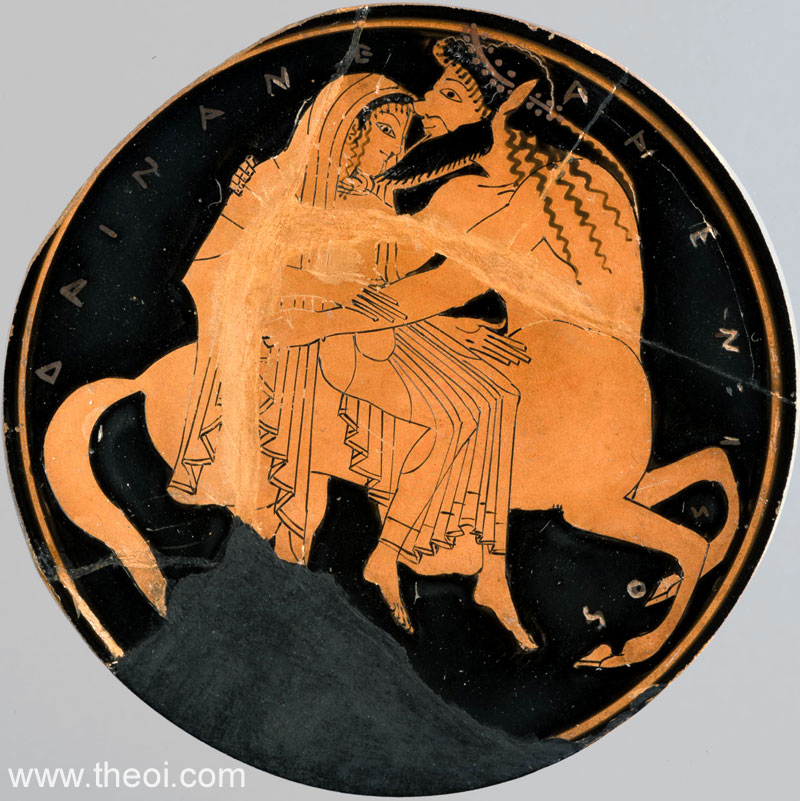
Pseudo-Apollodorus, Bibliotheca 2. 83 - 87 (trans. Aldrich) (Greek mythographer C2nd
A.D.) :
"Herakles (Heracles) asked for wine, but [the Kentauros (Centaur)] Pholos said that he was afraid to open
the cask which was owned jointly be the Kentauroi (Centaurs). But Herakles told him not to worry, and opened the
cask himself. Shortly thereafter, picking up the smell of the wine, the Kentauroi appeared at Pholos' cave,
armed with rocks and clubs of silver fir. The first two who ventured in, by name Ankhios and Agrios, Herakles
turned back with a volley of fire-brands; he sent arrows after the others . . . The remaining Kentauroi fled
this way and that, some to Mount Malea, Eurytion to Pholoe, Nessos (Nessus) to the Euenos (Evenus) river."
Pseudo-Apollodorus, Bibliotheca 2. 151 :
"With Deianeira (Deianira) he [Herakles] made his way to the Euenos (Evenus) river, where Nessos (Nessus)
the Kentauros (Centaur) had set up business ferrying travellers for a fee, maintaining that he had received the
franchise from the gods because of his moral rectitude. Herakles crossed the river on his own, but when Nessos
demanded payment even so, he let him conduct Deianeira across. En route he tried to rape her. Herakles heard her
scream, and shot Nessos in the heart with an arrow when he had landed. As Nessos was dying, he called Deianeira
to him and told her that if she wanted a love-potion to use on Herakles, she should mix the semen which he had
spilled on the ground with the blood that was flowing from the wound made by the arrowhead. She did this, and
kept the potion with her."
Pseudo-Apollodorus, Bibliotheca 2. 157 :
"In fear lest Herakles desire Iole more than herself [Deianeira], and in her belief that the blood of
Nessos was truly a love-potion, she doused the robe with it. Herakles put it on and started the sacrifice, but
soon the robe grew warm as the Hydra's venom began to cook his flesh."
Diodorus Siculus, Library of History 4. 36. 3 (trans. Oldfather) (Greek historian
C1st B.C.) :
"[Herakles] when in his journeying he arrived at the Euenos (Evenus) river he found there the Kentauros
(Centaur) Nessos who was conveying travellers across the river for a fee. Nessos carried Deianeira across first,
and becoming enamoured of her because of her beauty he tried to assault her. But when she called to her husband
for help Herakles shot the Kentauros with an arrow, and Nesos, struck even while he was having intercourse with
her and because of the sharpness of the blow being at once on the point of death, told Deianeira that he would
give her a love-charm to the end that Herakles would never desire to approach any other woman. He urged her,
accordingly, to take the seed which had fallen from him and, mixing it with olive oil and the blood which was
dripping from the barb of the arrow, to anoint with this the shirt of Herakles. This counsel, then, Nessos gave
Deianeira and at once breathed his last. And she put the seed, as Nessos had enjoined upon her, into a jar and
dipped in it the barb of the arrow and kept it all unknown to Herakles."
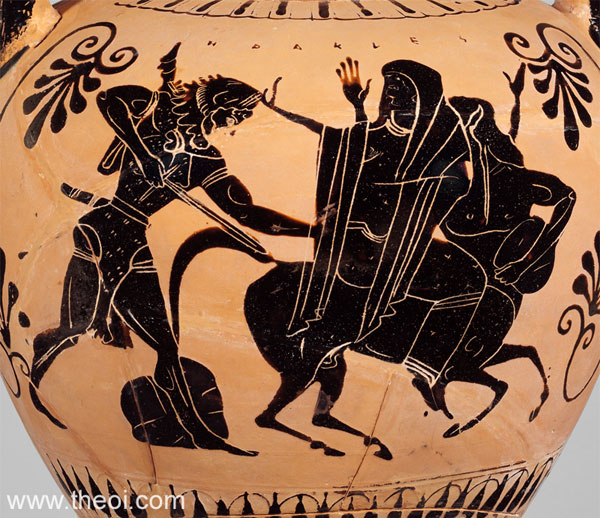
Diodorus Siculus, Library of History 4. 38. 1 :
"At Kenaion (Cenaeum) Herakles, wishing to perform a sacrifice, dispatched his attendant Likhas (Lichas) to
Deianeira his wife, commanding him to ask her for the shirt and robe which he customarily wore in the
celebration of sacrifices. But when Deianeira learned from Likhas of the love which Herakles had for Iole, she
wished him to have a greater affection for herself and so anointed the shirt with the love-charm which had been
given her by the Kentauros (Centaur) [Nessos], whose intention was to bring about the death of Herakles. Likhas,
then, in ignorance of these matters, brought back the garments for the sacrifice; and Herakles put on the shirt
which had been anointed, and as the strength of the toxic drug began slowly to work he met with the most
terrible calamity. For the arrow's barb had carried the poison of the adder, and when the shirt for this reason,
as it became heated, attacked the flesh of the body."
Strabo, Geography 10. 2. 5 (trans. Jones) (Greek geographer C1st B.C. to C1st A.D.)
:
"In earlier times it [the River Euenos (Evenus)] was called Lykormas (Lycormas). And there Nessos, it is
said, who had been appointed ferryman, was killed by Herakles because he tried to violate Deïaneira when he
was ferrying her across the river."
Strabo, Geography 9. 4. 8 :
"Here [in Ozolian Lokris], also, is Khalkis (Chalcis) . . . Here, also, is the hill Taphiassos, on which
are the tombs of Nessos and the other Kentauroi (Centaurs), from whose putrefied bodies, they say, flows forth
at the base of the hill the water which is malodorous and clotted; and it is on this account, they add, that the
tribe is also called Ozolian. [I.e. from ozein meaning ‘to smell’.]"
Pausanias, Description of Greece 10. 38. 1 (trans. Jones) (Greek travelogue C2nd
A.D.) :
"Nessos, ferrying on the Euenos (Evenus), was wounded by Herakles, but not killed on the spot, making his
escape to this country [Ozolian Lokris]; when he died his body rotted unburied, imparting a foul stench to the
atmosphere of the place."
Pausanias, Description of Greece 3. 18. 10 - 16 :
"[Among the scenes depicted on the throne of Apollon at Amyklai (Amyclae) near Sparta :] There is wrought .
. . Herakles avenging himself . . . upon Nessos at the river Euenos (Evenus) ."
Quintus Smyrnaeus, Fall of Troy 6. 283 ff (trans. Way) (Greek epic C4th A.D.)
:
"[Amongst the scenes depicted on the shield of Herakles' grandson Eurypylos :] There by Euenos' (Evenus')
torrent, in fierce wrath for his sweet bride [Deianeira], he [Herakles] laid with the arrow low Nessos in
mid-flight."
Ptolemy Hephaestion, New History Book 2 (summary from Photius, Myriobiblon 190)
(trans. Pearse) (Greek mythographer C1st to C2nd A.D.) :
"It was Aphrodite who, because of Adonis whom both she and Herakles loved, taught Nessos the Kentauros
(Centaur) the trap with which to snare Herakles."
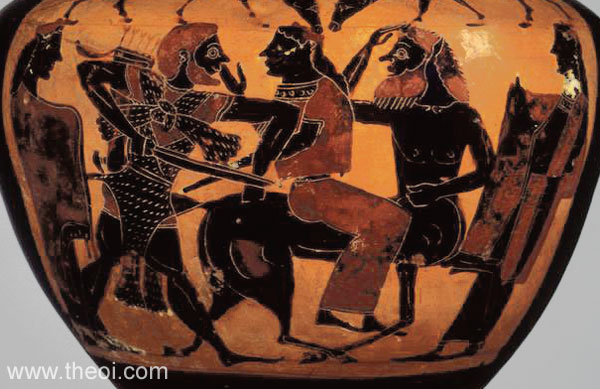
Philostratus the Younger, Imagines 16 (trans. Fairbanks) (Greek rhetorician C3rd
A.D.) :
"[Ostensibly a description of an ancient Greek painting :] Nessos (Nessus). Do not fear the river Euenos
(Evenus), my boy, though it rises in great waves and the water overflows its banks, for it is a painting; rather
let us examine its details, to see how and in what manner they are represented in art. Does not the divine
Herakles attract your attention as he advances thus into the middle of the river, his eyes flashing fire and
measuring off the distance to the mark, while he holds the bow in his outstretched left hand and still keeps his
right hand in the attitude of one who has let fly the arrow? for he holds it close to his breast. And what would
you say of the bowstring? Do you not seem to hear it sing as it lets fly the arrow? Whither is it aimed? Do you
see the Kentauros (Centaur) giving his last leap? This is Nessos, I think, who alone escaped the hand of
Herakles at Pholoë, when none but he escaped of those who wickedly attacked the hero. And he too is dead,
caught in a manifest wrong to Herakles. For Nessos ferried across any who called for this service, and Herakles
arrived, together with his wife and his son Hyllos (HYllus); and since the river seemed unfordable, he entrusted
his wife to Nessos to carry over, while he himself mounted his chariot along with his son and proceeded to cross
the river. Thereupon the Kentauros (Centaur) when he reached the bank cast wanton eyes on the woman and dared a
monstrous deed: and Herakles hearing her cry shot an arrow at Nessos. Deianeira (Deianira) is painted in the
attitude of one in danger, in the extremity of her fear stretching out her arms to Herakles, while Nessos, who
has just been hit by the arrow and is in convulsions, apparently has not yet given his own blood to Deianeira to
be put aside for use on Herakles. The boy Hyllos stands on his father's chariot, to the rail of which the reins
are fastened so that the horses will not run away, and he claps his hands in glee and laughs at what he has not
yet the strength to do."
Pseudo-Hyginus, Fabulae 34 (trans. Grant) (Roman mythographer C2nd A.D.) :
"Nessus, son of Ixion and Nubes (the Cloud) [Nephele], a Centaurus (Centaur), was asked by Dejanira to
carry her across the river Evenus, but as he was carrying her, in the very river he tried to ravish her. When
Hercules [Heracles] came there, and Dejanira implored his aid, he pierced Nessus with his arrows. As he died,
Nessus, knowing how poisonous the arrows were, since they had been dipped in the gall of the Lernaean Hydra,
drew out some of his blood and gave it to Dejanira, telling her it was a love-charm. If she wanted her husband
not to desert her, she should have his garments smneared with this blood. Dejanira, believing him, kept it
carefully preserved."
Pseudo-Hyginus, Fabulae 36 :
"Mindful of the instructions of Nessus, she [Deianeira] sent a servant named Lichas to take to Hercules a
robe dipped in the blood of the Centaurus (Centaur). A little of it fell to the earth, and when the sun touched
it, it began to burn. When Dejanira saw this, she knew that Nessus had spoken falsely, and sent a man to recall
the one to whom she had given the garment. Hercules had already put it on, and it started at once to
blaze."
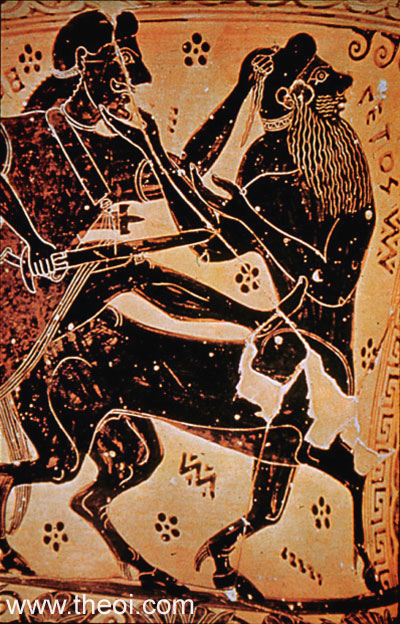
Ovid, Metamorphoses 9. 101 ff (trans. Melville) (Roman epic C1st B.C. to C1st A.D.)
:
"Savage Nessus lost his life for love of that same lady [Deianeira], when an arrow flew to pierce his side.
When Jove's [Zeus'] son [Heracles], was making for his native city's walls with his new bride, he reached the
rushing waters of broad Evenus, high beyond its wont. The river, swollen by the winter's rains and full of
whirlpools, poured impassable. And as he stood there, fearless for himself but anxious for his wife, Nessus
approached, mighty in muscle and knowing the fords well. ‘With my help she'll stand safe on the far
side,’ he volunteered: ‘You, use your strength and swim!’
To Nessus then Aonius [Heracles of Aonia, i.e. Thebes] gave his bride of Calydonis [Deianira of Calydon], pale
and afraid, dreading the river, dreading the Centaurus (Centaur) too. And then, just as he was, with all the
weight of lion-skin and quiver (club and bow he's thrown across), ‘Since I've begun,’ he cried,
‘I'll beat one river more!’ and never paused to take his time or pick the kindest water, and scorned
to use the current's services.
And now on the far bank and stooping for the bow he'd thrown, he heard a voice, his wife's, calling and sure
that Nessus had in mind a breach of trust, ‘You raping ravisher!’ he cried, ‘Where are you
going? So confident in your four feet! Nessus Two-Formed (biformis), listen! Hold off from me and mine.
Maybe you feel no dread of me--at least your father's [Ixion's] wheel should hold you back from lust and
lechery. Trust horse-strength if you will, you'll not escape. With wounds not feet I'll follow!’
His last words were proved at once: an arrow flew and pierced the fleeing centaur's back: out from his breast
the barbed point stuck. He wrenched the shaft away, and blood from both wounds spurted, blood that bore the
Lernaean's [Hydra's] poison. Nessus caught it up. ‘I'll not die unavenged,’ he thought and gave his
shirt soaked in warm gore to Deianira, a talisman, he said, to kindle love . . .
[Years later Deianeira heard a rumour that Heracles was going to forsake her and marry Iole :] Swaying from plan
to plan, at last she chose to send the shirt imbued with Nessus' blood to fortify her husband's failing love . .
. And Hercules receiving the gift and on his shoulders wore, in ignorance, the Hydra-poisoned gore."
Ovid, Metamorphoses 12. 308 ff :
"[During the battle between Kentauroi (Centaurs) and Lapithes :] Asbolus, the seer [of the Kentauroi]
warnings failed to keep his friends from war. He'd said to Nessus too who feared a wound, ‘No need to run
: you'll be kept safe to serve the bow of Hercules [Heracles].’"
Ovid, Metamorphoses 12. 453 ff :
"[In the battle between Kentauroi (Centaurs) and Lapithes:] I [Nestor] recall a hunting-spear from
[Centaur] Nessus' hand was buried in the groin of Cymelus."
Ovid, Heroides 9. 139 ff (trans. Showerman) (Roman poetry C1st B.C. to C1st A.D.)
:
"[Deianeira writes a letter to Herakles :] ‘Twice you have fought for the sake of men. In tears
Achelous gathered up his horns . . . [and] the half-man Nessus sank down in lotus-bearing Euenus (Evenus),
tingeing its waters with his equine blood. But why am I reciting things like these? Even as I write comes rumour
to me saying my lord is dying of the poison from my cloak.’"
Ovid, Heroides 9. 159 ff :
"[Deianeira, believing Herakles plans to forsake her for Iole, laments :] This one thing I deprecate, by
the most sacred bonds of our marriage-bed--that I seem to have plotted for your doom. Nessus, stricken with the
arrow in his lustful heart, ‘This blood,’ he said, ‘has power over love.’ The robe of
Nessus, saturated with poisonous gore, I sent to you."
Cicero, De Natura Deorum 3. 28 (trans. Rackham) (Roman rhetorician C1st B.C.)
:
"When Deianira gave Hercules the shirt soaked in the Centaurus' [Nessos'] blood, she did not intend to
injure him."
Seneca, Medea 771 ff (trans. Miller) (Roman tragedy C1st A.D.)
:
"[Amongst the fabulous ingredients used by the witch Medea in a spell :] To thee [Hekate (Hecate)]
I offer . . . the blood which Nessus, that traitor ferryman, bestowed as he expired. With these ashes the pyre
on Oeta sank down which drank in the poisoned blood of Hercules."
Valerius Flaccus, Argonautica 1. 130 ff (trans. Mozley) (Roman epic C1st A.D.)
:
"Argos adds paintings [to the hull of the ship Argo] of varied grace . . . On the other side is [Mount]
Pholoe and [the centaur] Rhoetus mad with much wine, and the strife that broke out over the Atracian maid [i.e.
the fight between the Centaurs and Lapiths at the wedding of Hippodameia] . . . Nessus the black Centaur is
fleeing, and in the midst of all [the Centaur] Hippasus leaning against the coverlets is burying his heads in an
empty golden goblet."
ANCIENT GREEK ART
SOURCES
GREEK
- Apollodorus, The Library - Greek Mythography C2nd A.D.
- Diodorus Siculus, The Library of History - Greek History C1st B.C.
- Strabo, Geography - Greek Geography C1st B.C. - C1st A.D.
- Pausanias, Description of Greece - Greek Travelogue C2nd A.D.
- Philostratus the Younger, Imagines - Greek Rhetoric C3rd A.D.
- Ptolemy Hephaestion, New History - Greek Mythography C1st - 2nd A.D.
ROMAN
- Hyginus, Fabulae - Latin Mythography C2nd A.D.
- Ovid, Metamorphoses - Latin Epic C1st B.C. - C1st A.D.
- Ovid, Heroides - Latin Poetry C1st B.C. - C1st A.D.
- Cicero, De Natura Deorum - Latin Rhetoric C1st B.C.
- Seneca, Medea - Latin Tragedy C1st A.D.
- Valerius Flaccus, The Argonautica - Latin Epic C1st A.D.
BIBLIOGRAPHY
A complete bibliography of the translations quoted on this page.
